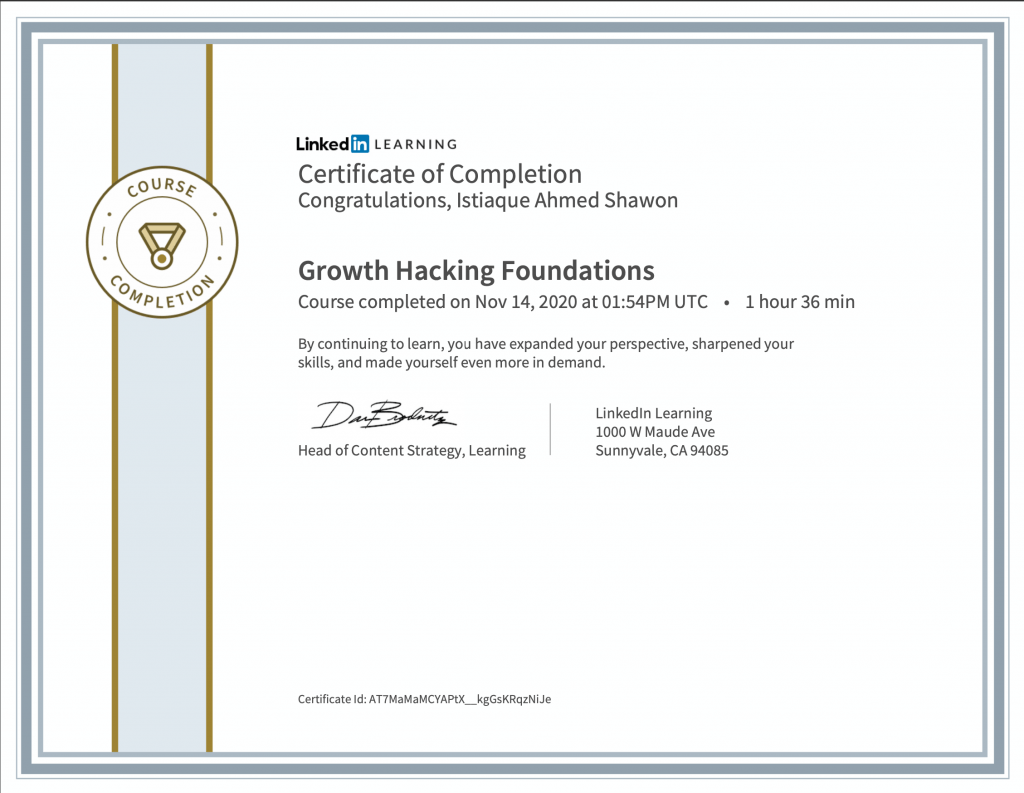A growth hacker is someone who uses creative, low-cost strategies to help businesses acquire and retain customers. Sometimes growth hackers are also called growth marketers, but growth hackers are not simply marketers. The way they are doing marketing that disrupts traditional marketing approaches. Growth hacking team is a combination of all; engineer, mkt, product, business analysis. Growth hacking is a process. It conducts rapid experimentation across the customer journey to accelerate growth. To find out what is working and whatnot. Like; why do users click a button, what to motivates them to buy, how much time to check out, what info do they read. Growth hacking is a single great idea and a system for achieving growth. Is a long term organizational shift. It has effects in almost every corner of a business.
There are four goals of growth hacking. The first goal of growth hacking is bridging the divide between marketing and product. Second, leverage rapid experimentation. Third, Adhere to the metrics. Fourth, foster a culture of the grift.
How to be a Growth Hacking Leader?
It’s a mindset, not a tool.
-Be bold
- Arms yourself with data
- Communicate your passion
- Set unreasonable goals
-Simplify
- Keep teams small
- Document only as necessary
- Limit meeting
- Centralize communication
- Encourage autonomy
-Go faster
-Grow your skills
Activities in Growth Hacking Process:
- Define goals (Create north star matric, Draft OKRs)
- Create ideas (Idea comes through a reflection of customer Journey, MKT Funnel, Product Life cycle and lean canvas)
- Test ideas (Run a design sprint)
- Collect data (Evaluate against the goal, inform decisions)
- Optimize and repeat
North star matric: is a single metric that captures the core value your product delivers to consumers. Example: Airbnb- Number of nights booked, WhatsApp- Number of messages sent, Facebook-Daily active users.
ICE Scoring model: Impact, confidence, ease
– Using customer interview
-Evaluate if people want your product
-NPS rating/ score
-Find out/ define users personas (describe the details, career facts, technology traits, short biography)
-What are they motivated by
-Where they spend most of the time
-Why they are interested in your product
-What will convince them to buy
OKRs
Objective: Goals for the quarter
i.e; Write an impactful growth hacking course for LinkedIn learning
Key Result-1: Measures outcomes
i,e; KR1: Finish writing all scripts,
KR-2: 5 pieces of positive feedback,
KR-33: Get 5000 views
NB: Assign metrics to each objective
-Usages metric
-Revenue metric
-Satisfaction metric
Click here to know about Lean Canvas for Marketing
The digital Marketing and Sales Funnel
Acquisition> Activation> Retention> Revenue> Referral
Acquisition: Focusing promotion using discount
Activation: Customer support increase activation, UI improve, Email drift campaign, teach about product benefits,
Retention: Send reminder, loyalty prog, improved features
Revenue:
Referral: Monetary benefits
Customer Journey:
The complete sum of experiences that customers go through when interacting with your product or services. As a growth marketer need to know this journey. Need to find out their touchpoints and other behaviours. Need to understand the customer journey in our brand and outside of our brand.
-Where did they enter?
-How do they spend their time?
-Where do they leave?
There are two types of users/customers; one party know your solution; another party know their problem not your solution exactly.
Type-1: Know your solution and,
Type-2: Know their problem but don’t know about your solution
Those who know your solution try to find out their following facts;
- How did they become aware?
- What did they do next?
- What motivated them to buy?
- How did they progress in the funnel?
Touchpoints Ideas:
- Email drip campaign
- Design a pop-up ad
- Offer paid plan alongside a trial
Take action:
- Focus on North Star Metric and OKRs
- Evaluate for leverage
- Understand existing touch points
Growth Loop:
Example: Hotmail offered free to email at 1996
Customer sign up> Send email> Other received> And sign up hot mail to see the email
Technology Adoption:
Innovator> Early Adopters> Early Majority> Late Majority> Laggard
Target your customer in different stage wisely:
Example: Facebook chosen college student (Tech aware people) first to use its product. A company at different levels should have different growth technique.
- Development stage: research the competition, understand users, determine product requirements.
- Introduction stage: focusing on testing, deploy growth techniques.
- Growth stage: deploy strategy, track your progress.
- Maturity stage: recognize a stop in growth, understand preference change.
Product Market Fit:
Being in a good market with a product that can satisfy that market.
Bad product-market fit:
- A misunderstood product
- Customer don’t see value
- No word of mouth
- No reviews
- Long sales cycle
- CAC cost is high
Good product-market fit:
- Good growth curve
- Easy-to-close deals
- Acquiring customer organically
- Press attention
Message Customer fit:
The right message repeatedly reaching the right customer in the right market.
Common reasons for failure:
- Data was misinterpreted
- Mis understanding of customer
- Subpar execution
Turn customers into believers:
- Remove doubt
- Improve their experiences
- Listen to their needs
- Engage with them
Turn customers into advocate:
- Always follow-through
- Provide them with something special
Retain your users:
- Retention is an educating process/problem
- 5% retention will bring 30% profitability
- Retention vs growth?
- List down why users are not coming back
- Try to talk about your value to the customer
- Pain points and solution
- Ask them/ do survey why they are not coming
Data-Driven Growth Marketing:
Analyzing data is the key
Questions to Ask:
- Acquisition: How are customers finding us?
- Activation: What are customers saying?
- Retention: Why are customer leaving or staying?
- Referral: Would customer share this with their friends?
- Revenue: Are we making money?
A few more questions to ask:
- Acquisition: # of conversion, CPA
- Activation: Time in the product, Customer Support Ticket, Volume, LTV
- Retention: Churn rate and recapture rate
- Referral: Program growth rate
- Revenue: Monthly revenue
Monthly recurring revenue (MRR):
- The measurement of your predictable revenue stream
- Parameter of growth
Churn rate:
- Can calculate by BareMatrics, ChartMogul
CAC:
- CAC VS CLV
I’m finishing here. Now, it’s your turn to make your own plan. Cheers!






